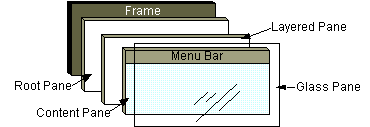Could you explain these statements?
-
25-06-2021 - |
Question
I've come across an example on the internet which uses both of these statements:
dp.add( bg , new Integer( 50 ) );
(dp being a JDesktopPane object and bg being a JLabel)
setLayeredPane( dp );
If you would like to know how they are used, then this is what I was looking at: http://www.coderanch.com/t/329874/GUI/java/put-background-image-swing
I'm a beginner when it comes to Java and I understand the rest of the example, just not these two statements - and it bugs me that I don't know what they do! The bit that confuses me the most is "new Integer( 50 ) )" but please could you give a thorough, beginner-friendly explanation of both? I'd much appreciate it.
Thanks in advance,
Alex.
Solution
See the documentation on JLayeredPane.
Each layer is a distinct integer number. The layer attribute can be set on a
Componentby passing anIntegerobject during the add call. For example:layeredPane.add(child, JLayeredPane.DEFAULT_LAYER);or
layeredPane.add(child, new Integer(10));
You can find the integer values of the default layer values here.
dp.add(lbl,new Integer(50));
The above adds the JLabel component lbl to the JDesktopPane (which is a JLayeredPane) with the specified layer of 50. Components added to dp with layers that are less than 50 will be rendered before, while components with layers greater than 50 will be rendered after -- i.e. a simple depth order, where greater layers refer to nearer components.
setLayeredPane( dp );
This sets the JFrame represented by the ImagePaneTest object (which probably shouldn't be a subclass) to use dp as its layered pane. You can see how Swing top-level containers work in the relevant Java Tutorial.
